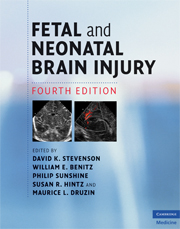Book contents
- Frontmatter
- Contents
- List of contributors
- Foreword
- Preface
- Section 1 Epidemiology, pathophysiology, and pathogenesis of fetal and neonatal brain injury
- Section 2 Pregnancy, labor, and delivery complications causing brain injury
- 5 Prematurity and complications of labor and delivery
- 6 Risks and complications of multiple gestations
- 7 Intrauterine growth restriction
- 8 Maternal diseases that affect fetal development
- 9 Obstetrical conditions and practices that affect the fetus and newborn
- 10 Fetal and neonatal injury as a consequence of maternal substance abuse
- 11 Hypertensive disorders of pregnancy
- 12 Complications of labor and delivery
- 13 Fetal response to asphyxia
- 14 Antepartum evaluation of fetal well-being
- 15 Intrapartum evaluation of the fetus
- Section 3 Diagnosis of the infant with brain injury
- Section 4 Specific conditions associated with fetal and neonatal brain injury
- Section 5 Management of the depressed or neurologically dysfunctional neonate
- Section 6 Assessing outcome of the brain-injured infant
- Index
- Plate section
- References
8 - Maternal diseases that affect fetal development
from Section 2 - Pregnancy, labor, and delivery complications causing brain injury
Published online by Cambridge University Press: 12 January 2010
- Frontmatter
- Contents
- List of contributors
- Foreword
- Preface
- Section 1 Epidemiology, pathophysiology, and pathogenesis of fetal and neonatal brain injury
- Section 2 Pregnancy, labor, and delivery complications causing brain injury
- 5 Prematurity and complications of labor and delivery
- 6 Risks and complications of multiple gestations
- 7 Intrauterine growth restriction
- 8 Maternal diseases that affect fetal development
- 9 Obstetrical conditions and practices that affect the fetus and newborn
- 10 Fetal and neonatal injury as a consequence of maternal substance abuse
- 11 Hypertensive disorders of pregnancy
- 12 Complications of labor and delivery
- 13 Fetal response to asphyxia
- 14 Antepartum evaluation of fetal well-being
- 15 Intrapartum evaluation of the fetus
- Section 3 Diagnosis of the infant with brain injury
- Section 4 Specific conditions associated with fetal and neonatal brain injury
- Section 5 Management of the depressed or neurologically dysfunctional neonate
- Section 6 Assessing outcome of the brain-injured infant
- Index
- Plate section
- References
Summary
Introduction
Most maternal diseases that affect fetal development probably do so by multiple mechanisms. However, for the purpose of study, it is useful to categorize diseases by mechanism of teratogenesis. Maternal disease can effect fetal development in the following ways: (1) specific effects of metabolic end products or antibodies, (2) placental insufficiency, (3) maternal medications or toxic exposures, (4) infection, and (5) genetic disease. The main focus of this chapter is to discuss maternal disease that has primary effects on fetal development. Placental insufficiency, medication/toxic exposures, infection, and genetic disease are mentioned for the sake of completeness and will be discussed briefly. All maternal illnesses, whether they directly affect the fetus or not, can cause iatrogenic premature delivery in the case of an unstable mother.
Specific fetal effects of over- or underproduced metabolic end products or antibodies
Maternal diseases that cause specific fetal disease can do so by transplacental passage of a toxic maternal metabolic end product (e.g., high glucose or high androgen), by lack of transplacental passage of an essential maternal metabolic end product (e.g., thyroxine), or by transplacental passage of a maternal antibody. Well-studied maternal diseases that are prototypes for the above-described mechanisms of fetal disease include (1) diabetes mellitus, congenital adrenal hyperplasia, and phenylketonuria (toxic metabolic end product), (2) hypothyroidism (maternal underproduction of an essential metabolic end product), and (3) Grave's disease, systemic lupus erythematosus, and rhesus alloimmunization (maternal antibody transfer). There are many other examples of maternal diseases which affect fetal development. However, the above-mentioned prototypic diseases will be discussed below.
- Type
- Chapter
- Information
- Fetal and Neonatal Brain Injury , pp. 96 - 102Publisher: Cambridge University PressPrint publication year: 2009
References
- 2
- Cited by



